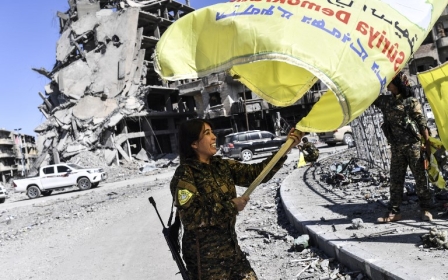Pentagon signals open-ended troop commitment in Syria

The US military plans on staying in Syria as long as necessary to ensure the Islamic State (IS) group does not return, a Pentagon official said on Tuesday, as the fight against the militancy winds down.
"We are going to maintain our commitment on the ground as long as we need to - to support our partners and prevent the return of terrorist groups," Pentagon spokesman Eric Pahon told AFP news agency.
The United States currently has approximately 2,000 troops on the ground in Syria, where they have been helping train and advise Kurdish and Arab partner forces in the fight against IS.
The US does not have the permission or support of the Syrian government in Damascus for its presence in the country, instead backing groups that oppose President Bashar al-Assad.
Now that the militants have been cleared from all but a few pockets of territory, the US is assessing its future presence in the civil war-torn nation.
Pahon said the US troop commitment would be "conditions-based," meaning no timeline will determine any pull out.
"To ensure an enduring defeat of ISIS, the coalition must ensure it cannot regenerate, reclaim lost ground or plot external attacks," he said, using a different acronym for IS.
"The United States will sustain a 'conditions-based' military presence in Syria to combat the threat of a terrorist-led insurgency, prevent the resurgence of ISIS, and to stabilise liberated areas."
The United States will sustain a 'conditions-based' military presence in Syria to combat the threat of a terrorist-led insurgency
- Eric Pahon, Pentagon spokesman
Syria's conflict began in March 2011 with anti-government protests, but quickly spiralled into a bitter and complex civil war, with IS just one element in a shifting matrix of players.
The US military, along with other nations in a US-led coalition, began bombing IS in late 2014 but until now has largely declined to address what its role in the tangled conflict might be after the militants are beaten.
"We are going to be in Syria for some time yet. I don't want to say that's 10 years, I also don't want to say it's not," Pahon said.
"What people should not expect is that we are going to see the last ISIS guy die and then we are going to abandon our partners," he said.
Russia and Iran
The open-ended US commitment in Syria will likely rile Russia, which since late 2015 has conducted a separate military campaign to prop up the government of President Bashar al-Assad.
Unlike Russia, the United States is not in Syria at the request or approval of the Damascus government.
Washington has cited Article 51 of a UN charter allowing for self-defence of partner forces as legal justification for its military engagement, and that will remain the case going forward.
Still, successive US administrations have themselves been criticised for failing to articulate a coherent plan for Syria, and the elapsed time has seen Russian and Iranian influence bloom.
Pahon stressed the US would maintain its support for the Kurdish-Arab alliance called the Syrian Democratic Forces (SDF) that have done most of the ground fighting against IS.
America's support to the SDF has infuriated NATO ally Turkey, which sees the Kurdish component as "terrorists".
"Operating under recognised international authorities, the US military will continue to support local partner forces in Syria to stabilise liberated territory," Pahon said.
These efforts will include restoration of essential services, de-mining and removal of explosive materials, as well as facilitating the flow of humanitarian aid.
"This will also set the conditions for internally displaced people and refugees to safely return," Pahon added.
More than 340,000 people have died in the Syrian war, and millions more have been displaced.
Middle East Eye propose une couverture et une analyse indépendantes et incomparables du Moyen-Orient, de l’Afrique du Nord et d’autres régions du monde. Pour en savoir plus sur la reprise de ce contenu et les frais qui s’appliquent, veuillez remplir ce formulaire [en anglais]. Pour en savoir plus sur MEE, cliquez ici [en anglais].




